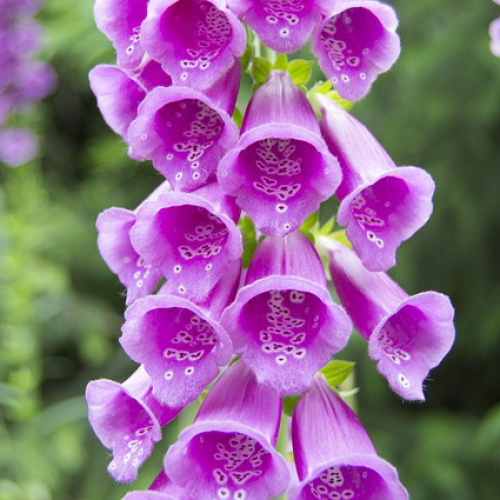Perennials Digitаlis

Description
Characteristic Features of Foxglove
Digitalis (Foxglove) is species of annual, biannual, and perennial grasses and dwarf shrubs in the family Plantaginaceae; it was formerly placed in the figwort family Scrophulariaceae. In the wild, Digitalis occurs in Europe, Asia, Africa, and the Mediterranean. It grows mainly in the meadows, glades, edges of woods, and near water.
Its common name "finger flower" refers to its untypically shaped flowers that resemble a thimble (the Latin "digitus" means "finger"). In Germany, it is commonly believed that the flowers of Foxglove serve as hats for the elves. A legend goes that Foxgloves grew out of thimbles that the stepmother took away from her stepdaughter and buried in the garden. Foxgloves contain poison because the plants sprouted out of the stepdaughter's hatred for her stepmother.
Foxglove has hard, erect stems 30 to 150 centimetres tall. The leaves are mostly lanceolate or oval, pointed, light green, arranged regularly. Large flowers, collected in spikes at the top of the stem are bell-shaped and range in colour from white and yellow to red and magenta. Foxglove blossoms throughout the summer. The fruit is a capsule with lots of small brown seeds that remain viable for 2-3 years. However, typically only half of the seeds germinate. One gram contains about 10,000 seeds. Seeds are harvested in late summer and stored in the capsules until spring.
Most species of Foxglove are medicinal plants and, thanks to glycosides contained in the leaves, have been used to treat heart failure since the 5th century BC. However, it should be noted that it is strictly forbidden to prepare infusions at home, as shoots of the plant are toxic and can cause serious poisoning. Avoid planting Foxglove within the reach of children.
In gardens and parks, Foxglove is often grown near the walls of houses or along the fences near low bushes, or in mixed borders together with such companion plants as rhododendrons, roses, honeysuckle, dicentra, hosta, primroses, astrantia, astilba, geraniums, and peonies. Foxgloves are also grown for cutting and in containers. Low-growing Foxglove varieties are used for forcing. To do so, pot the plant and place indoors at about 15 ° C. Foxglove also makes an excellent honey plant, its flowers are extremely attractive to insects that often remain inside the flowers for the night in cold weather.
The genus Digitalis is represented by about 35 species, the most popular of which are:
Straw Foxglove or (Small) Yellow Foxglove (Digitalis lutea) reaches a height of one metre and has smooth, oval leaves and bright yellow flowers that bloom in late summer.
Rusty Foxglove (Digitalis ferruginea) is tall plant with lanceolate leaves and middle-sized red flowers.
Big-Flowered Foxglove or Large Yellow Foxglove (Digitalis grandiflora) is a perennial plant cultivated as a biennial. It grows to 110 centimetres in height and has oblong lanceolate leaves and large yellow flowers.
Common Foxglove, Purple Foxglove, or Lady's Glove (Digitalis purpurea) is also cultivated as a biennial. It reaches one and a half metres tall and has hairy stems, round leaves, and white, beige, pinkish, or purple flowers.
Ciliated Foxglove or Hairy Foxglove (Digitalis ciliata) is a perennial plant growing to 30-65 centimetres tall, with lanceolate leaves and small white yellow or beige flowers.
Woolly Foxglove or Grecian Foxglove (Digitalis lanata) grows in Moldova and is notable for its small yellow brown flowers and lilac netting.
The Secrects to Successfully Growing Foxglove
Foxglove is drought- and frost-resistant and does not have any specific requirements about location. However, for profuse flowering, plant it in full sun to partial shade. Any fertile soil with good drainage will do.
The basic care includes watering in dry weather, removing weeds, loosening the soil, fertilization twice a season, and regular deadheading of spent inflorescences to prolong the flowering period. Perennial Foxglove needs mulching with compost every autumn to ensure that the plant overwinters well and the roots are not exposed. To avoid cross-pollination, planting several different varieties close to each other is not recommended.
Foxglove is easily propagated by seed. The seeds are typically sown out in April and May (or in the summer) in rows 40 centimetres apart. Surface sow the seeds, sprinkle them lightly with soil and water sparingly. Prick out the seedlings to avoid overcrowding and plant them to a permanent location in late spring. You can also sow the seeds indoor for seedlings.
Alternatively, at the end of flowering, cut off several stems on the top. The plants will develop basal rosettes within a month. Once they have at least three sets of true leaves, cut the rosettes, plant out, water carefully making sure water does not get on the leaves, and protect from direct sunlight for some time. Before the onset of winter, the plants get strong and will bloom the next year.
Potential Problems
In bad care, Foxglove can get root rot, powdery mildew, nematodes, mosaicism, or leaf curl. The affected part should be removed immediately, and all plants should be treated with special fungicides.
Sometimes Foxglove may be affected by leaf spot. To control the disease, treat with copper fungicides.
Of many pests, the plant is typically only attacked by aphids and moths. Control the pests with Topaz.







 334
334







